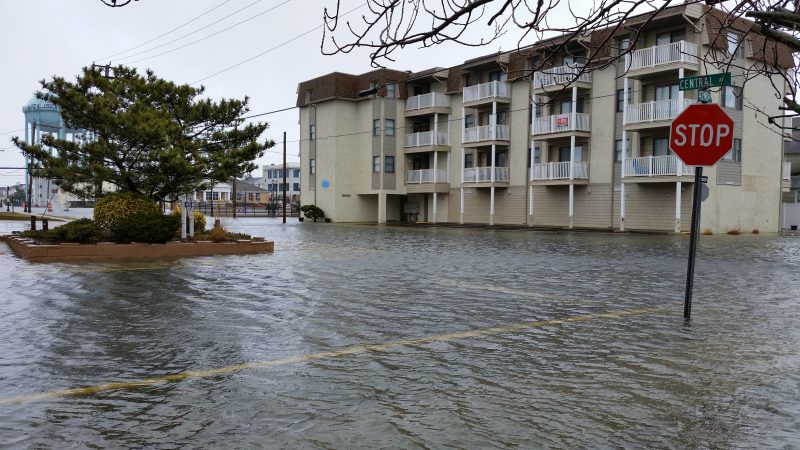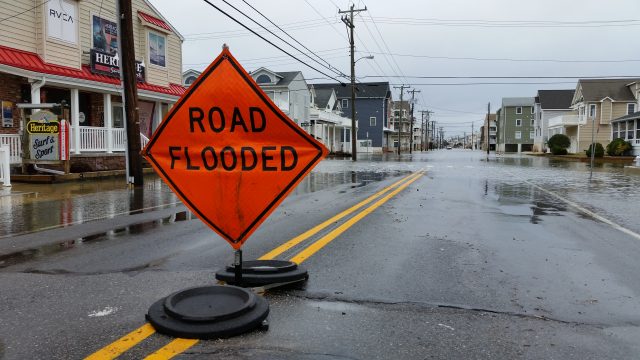By Donald Wittkowski
A new flood-mitigation study, more than a year in the making, recommends that Sea Isle City should implement a series of measures ranging from pumping stations to stone walls to protect the low-lying barrier island from stormwater.
The study, though, acknowledges that it will be impossible for the city to prevent flooding altogether, no matter what course of action is taken to fight something that has become “more problematic in recent years.”
“We cannot stop flooding,” according to the 24-page document prepared by the engineering firm Maser Consulting P.A. of Egg Harbor Township and released Monday by the city. “What can be done is to mitigate or reduce the risk of flooding and reduce the adverse impacts caused by flooding.”
The city plans to make a public presentation on the study, but has not yet announced a date. City Council President Jack Gibson said the presentation is expected soon.
In the study, Maser notes that Sea Isle has already implemented an array of flood-mitigation initiatives, such as restoring the beaches and dunes, building bulkheads along the bayfront, upgrading the drainage systems and erecting berms and levees.
Replenishment of the beaches and dunes has been going on for more than 50 years with the help of the New Jersey Department of Environmental Protection and the U.S. Army Corps of Engineers, the study says. In 2015 and 2016, nearly 3 million cubic yards of new sand was pumped on Sea Isle’s entire shoreline during a $40 million beach replenishment project.
However, Maser concludes that even more can be done by Sea Isle to alleviate flooding. Although Maser does not include cost estimates in the study, it recommends that the city should add more funding in its five-year capital plan to finance flood-control projects.
“Flooding issues, particularly bay flooding issues, have become more problematic in recent years,” the study says with a sense of urgency.

Previously, city officials warned that it would take a huge amount of money to finance a comprehensive flooding plan, including the construction of better drainage systems, new pumping stations, dikes and road improvements. They have discussed pursuing county, state and federal grants to help with the cost.
In one key recommendation, Maser is urging the city to build stormwater pumping stations in areas susceptible to flooding. Pumping stations would not prevent flooding, but are a way to flush stormwater off the streets faster than existing drainage systems, the study says.
The city is expected to begin construction this month on its first pumping station in the flood-prone neighborhood of 38th Street and Sounds Avenue. The pumping station will complement repaved roads, new drainage improvements and a nearly 4-foot-high rock wall that runs along the sides of 38th Street to protect the bayfront neighborhood.
Maser is also recommending that the city should install check valves on all of its outfall systems that currently don’t have them. It is making the same recommendation for county-operated outfall pipes in Sea Isle that currently lack check valves.
Check valves operate by water pressure. When tidal waters rise, they exert pressure on the valves to close. This effectively keeps tidal water out of the system, the study says.
According to the study, the city should also build berms along roads that are adjacent to the marshes or are in low-lying areas. Berms consist of a combination of dirt wrapped in a geo-textile material and a stone wall that acts as a barrier against stormwater.

The city has conducted a mapping program to identify stormwater facilities and drainage basins throughout the island as part of the flooding study.
Maser makes it clear that the city should continue working with the county, state and federal governments on flood-mitigation measures. Maser’s study is not a comprehensive flood-control plan.
“This study is the first step in identifying specific problem areas and should be considered a planning tool,” it says.
Independent of the study, Sea Isle has approved funding for a citywide early-warning system to keep residents and tourists away from flooded areas. It is billed as the largest project of its kind for any municipality in New Jersey.
As described during a presentation in May to City Council, the $160,000 flood-warning system would include 56 flashing road signs scattered throughout town in neighborhoods most vulnerable to stormwater.








